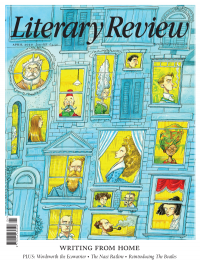Kieran Pender
Fear & Loathing on the Internet
War for Eternity: The Return of Traditionalism and the Rise of the Populist Right
By Benjamin R Teitelbaum
Allen Lane 336pp £20
Going Dark: The Secret Social Lives of Extremists
By Julia Ebner
Bloomsbury 348pp £16.99
To better understand how the far right and alt-right have gained political salience in recent years, a curious observer might seek to examine the ideologues and thinkers at the core of these movements. Alternatively, they might look in the opposite direction, eschewing the bigger philosophical picture to focus on the everyday, exploring interactions among the rank and file. These are the divergent but complementary approaches taken by Benjamin Teitelbaum and Julia Ebner in their new books. Together, they provide timely, insightful and often troubling accounts of the new political reality.
Teitelbaum, an assistant professor at the University of Colorado, Boulder, begins War for Eternity with an admission. ‘I am by trade an ethnographer, not a journalist,’ he writes. His book sits ‘in the blurred space between that method and investigate journalism’. He draws on over twenty hours of on-the-record interviews with Steve Bannon, plus what he gleaned during extensive travels across Europe and the United States. War for Eternity is predominantly an attempt to understand the ideology of Bannon and other important alt-right figures. It also explores how philosophical affinities have drawn them together.
Teitelbaum focuses on three primary figures: Bannon, campaign chief and later chief strategist to Donald Trump; Aleksandr Dugin, an influential confidant of Vladimir Putin; and Olavo de Carvalho, a close adviser to Brazil’s president, Jair Bolsonaro. What links these three men, according to Teitelbaum, is a shared adherence to Traditionalism,

Sign Up to our newsletter
Receive free articles, highlights from the archive, news, details of prizes, and much more.@Lit_Review
Follow Literary Review on Twitter
Twitter Feed
It wasn’t until 1825 that Pepys’s diary became available for the first time. How it was eventually decrypted and published is a story of subterfuge and duplicity.
Kate Loveman tells the tale.
Kate Loveman - Publishing Pepys
Kate Loveman: Publishing Pepys
literaryreview.co.uk
Arthur Christopher Benson was a pillar of the Edwardian establishment. He was supremely well connected. As his newly published diaries reveal, he was also riotously indiscreet.
Piers Brendon compares Benson’s journals to others from the 20th century.
Piers Brendon - Land of Dopes & Tories
Piers Brendon: Land of Dopes & Tories - The Benson Diaries: Selections from the Diary of Arthur Christopher Benson by Eamon Duffy & Ronald Hyam (edd)
literaryreview.co.uk
Of the siblings Gwen and Augustus John, it is Augustus who has commanded most attention from collectors and connoisseurs.
Was he really the finer artist, asks Tanya Harrod, or is it time Gwen emerged from her brother’s shadow?
Tanya Harrod - Cut from the Same Canvas
Tanya Harrod: Cut from the Same Canvas - Artists, Siblings, Visionaries: The Lives and Loves of Gwen and Augustus John by Judith Mackrell
literaryreview.co.uk